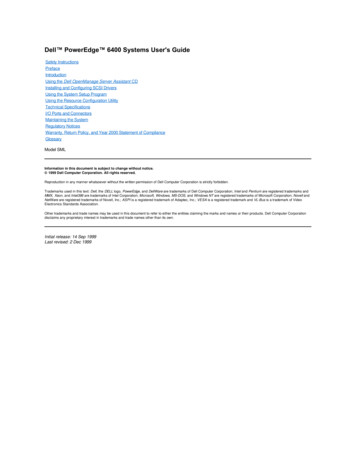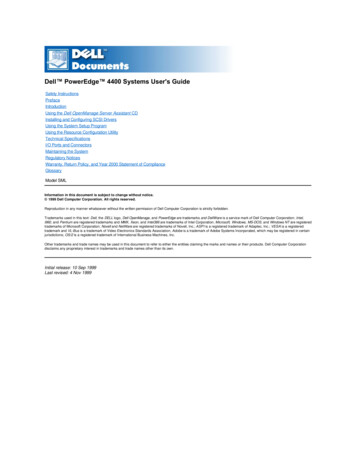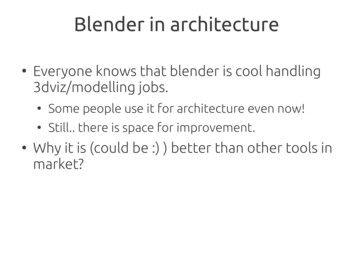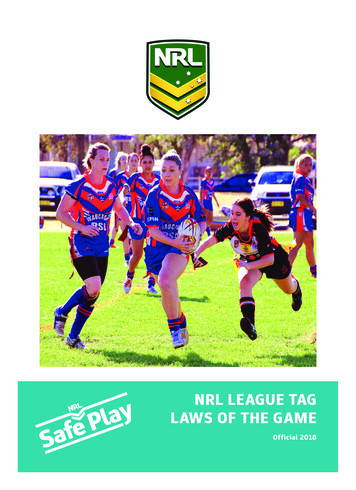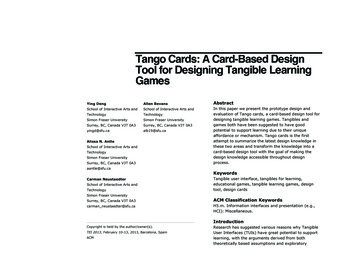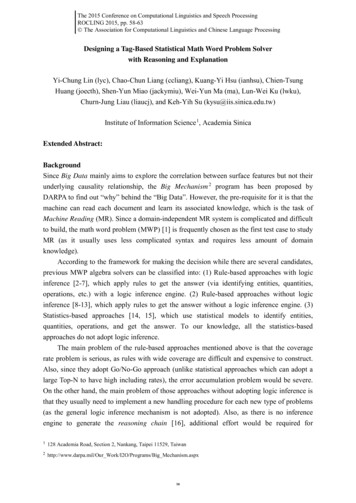
Transcription
The 2015 Conference on Computational Linguistics and Speech ProcessingROCLING 2015, pp. 58-63 The Association for Computational Linguistics and Chinese Language ProcessingDesigning a Tag-Based Statistical Math Word Problem Solverwith Reasoning and ExplanationYi-Chung Lin (lyc), Chao-Chun Liang (ccliang), Kuang-Yi Hsu (ianhsu), Chien-TsungHuang (joecth), Shen-Yun Miao (jackymiu), Wei-Yun Ma (ma), Lun-Wei Ku (lwku),Churn-Jung Liau (liaucj), and Keh-Yih Su (kysu@iis.sinica.edu.tw)Institute of Information Science 1, Academia SinicaExtended Abstract:BackgroundSince Big Data mainly aims to explore the correlation between surface features but not theirunderlying causality relationship, the Big Mechanism 2 program has been proposed byDARPA to find out “why” behind the “Big Data”. However, the pre-requisite for it is that themachine can read each document and learn its associated knowledge, which is the task ofMachine Reading (MR). Since a domain-independent MR system is complicated and difficultto build, the math word problem (MWP) [1] is frequently chosen as the first test case to studyMR (as it usually uses less complicated syntax and requires less amount of domainknowledge).According to the framework for making the decision while there are several candidates,previous MWP algebra solvers can be classified into: (1) Rule-based approaches with logicinference [2-7], which apply rules to get the answer (via identifying entities, quantities,operations, etc.) with a logic inference engine. (2) Rule-based approaches without logicinference [8-13], which apply rules to get the answer without a logic inference engine. (3)Statistics-based approaches [14, 15], which use statistical models to identify entities,quantities, operations, and get the answer. To our knowledge, all the statistics-basedapproaches do not adopt logic inference.The main problem of the rule-based approaches mentioned above is that the coveragerate problem is serious, as rules with wide coverage are difficult and expensive to construct.Also, since they adopt Go/No-Go approach (unlike statistical approaches which can adopt alarge Top-N to have high including rates), the error accumulation problem would be severe.On the other hand, the main problem of those approaches without adopting logic inference isthat they usually need to implement a new handling procedure for each new type of problems(as the general logic inference mechanism is not adopted). Also, as there is no inferenceengine to generate the reasoning chain [16], additional effort would be required for1128 Academia Road, Section 2, Nankang, Taipei 11529, Taiwan2http://www.darpa.mil/Our Work/I2O/Programs/Big Mechanism.aspx58
generating the explanation.To avoid the problems mentioned above, a tag-based statistical framework which is ableto perform understanding and reasoning with logic inference is proposed in this paper. Itanalyzes the body and question texts into their associated tag-based 3 logic forms, and thenperforms inference on them. Comparing to those rule-based approaches, the proposedstatistical approach alleviates the ambiguity resolution problem, and the tag-based approachalso provides the flexibility of handling various kinds of possible questions with the samebody logic form. On the other hand, comparing to those approaches not adopting logicinference, the proposed approach is more robust to the irrelevant information and could moreaccurately provide the answer. Furthermore, with the given reasoning chain, the explanationcould be more easily generated.Proposed FrameworkThe main contributions of our work are: (1) proposing a tag-based logic representation suchthat the system is more robust to the irrelevant information and could provide the answermore precisely; (2) proposing a unified statistical framework for performing reasoning fromthe given text.(a) Math Word Problem Solver Diagram(b) Problem Resolution DiagramFigure 1. The block diagram of the proposed Math Word Problem Solver.The block diagram of the proposed MWP solver is shown in Figure 1. First, everysentence in the MWP, including both body text and the question text, is analyzed by theLanguage Analysis module, which transforms each sentence into its corresponding semanticrepresentation tree. The sequence of semantic representation trees is then sent to the ProblemResolution module, which adopts the logic inference approach to obtain the answer for eachquestion. Finally, the Explanation Generation (EG) module will explain how the answer isThe associated modifiers in the logic form (such as verb(q1,進貨), agent(q1,文具店), head(n1p,筆), color(n1p,紅), color(n2p,藍) in the example of the next page) are regarded as various tags (or conditions) for selecting theappropriate information related to the question specified later.359
obtained (in natural language text) according to the given reasoning chain.As the figure depicted, the Problem Resolution module in our system consists of threecomponents: Solution Type Classifier (TC), Logic Form Converter (LFC) and InferenceEngine (IE). TC suggests a way to solve the problem for every question in an MWP. In orderto perform logic inference, the LFC first extracts the related facts from the given semanticrepresentation tree and then represents them as First Order Logic (FOL) predicates/functions[16]. It also transforms each question into an FOL-like utility function according to theassigned solution type. Finally, according to inference rules, the IE derives new facts fromthe old ones provided by the LFC. Besides, it is also responsible for providing utilities toperform math operations on related facts.Take the MWP “文具店進貨 2361 枝紅筆和 1587 枝藍筆 (A stationer bought 2361 redpens and 1587 blue pens), 文具店共進貨幾枝筆 (How many pens did the stationer buy)?”as an example. Figure 2 shows the Semantic Representation of this example.{進貨.buy 買:{進貨.buy 買:agent {文具店},theme {和.and({筆.PenInk 筆墨:agent {文具店},共.quantity {all 全},theme {筆.PenInk 筆墨:幾.quantity {Ques 疑問}quantity {2361},color {紅.red 紅}},},{筆.PenInk 筆墨:}quantity {1587},color {藍.blue 藍}})},}Figure 2 (a)Figure 2 (b)Figure 2. Semantic Representation of (a)“文具店進貨 2361 枝紅筆和 1587 枝藍筆(A stationer bought 2361 red pens and 1587 blue pens), (b)文具店共進貨幾枝筆(How many pens did the stationer buy)?”Based on the semantic representation given above, the TC will assign the operationtype “Sum” to it. The LFC will then extract the following two facts from the first sentence:quan(q1,枝,n1p) 筆)&color(n1p,紅)quan(q2,枝,n2p) 筆)&color(n2p,藍)The quantity-fact “2361 枝紅筆 (2361 red pens)” is represented by “quan(q1,枝,n1p) 2361”,60
where the argument “n1p” 4 denotes “紅筆 (red pens)” due to the facts “head(n1p,筆)” and“color(n1p,紅)”. Likewise, the quantity-fact “1587 枝藍筆 (1587 blue pens)” is representedby “quan(q2,枝,n2p) 1587”. The LFC also issues the utility call “ASK ��店))” (based on the assigned solution type) for the question.Finally, the IE will select out two quantity-facts “quan(q1,枝,n1p) 2361” and “quan(q2,枝,n2p) 1587”, and then perform “Sum” operation on them to obtain “3948”.If the question in the above example is “文具店共進貨幾枝紅筆 (How many red pensdid the stationer buy)?”, the LFC will generate the following facts and utility call for this newquestion:head(n3p,筆)&color(n3p,紅)ASK ��店))As the result, the IE will only select the quantity-fact “quan(q1,枝,n1p) 2361”, because themodifier in QLF (i.e., “color(n3p,紅)”) cannot match the associated modifier “藍 (blue)” (i.e.,“color(n2p,藍)”) of “quan(q2,枝,n2p) 1587”. After performing “Sum” operation on it, wethus obtain the answer “2361”. (We will skip EG due to space limitation. Please refer to [17]for the details).Preliminary ResultsCurrently, we have completed all the associated modules (including Word Segmenter,Syntactic Parser, Semantic Composer, TC, LFC, IE, and EG), and have manually annotated75 samples (in our elementary school math corpus) as the seed corpus (with syntactic tree,semantic tree, logic form, and reasoning chain annotated). Besides, we have cleaned theoriginal elementary school math corpus and encoded it into the appropriate XML format.There are total 23,493 problems divided into six grades; and the average number of words ofthe body text is 18.2 per problem. Table 3 shows the statistics of the converted corpus.We have completed a prototype system and have tested it on the seed corpus. Thesuccess of our pilot run has demonstrated the feasibility of the proposed approach. We plan touse the next few months to perform weakly supervised learning [18] and fine tune the system.4The subscript “p” in “n1p” indicates that “n1p” is a pseudo nonterminal derived from the nonterminal “n1”, which has fourterminals“2361”, “枝”, “紅” and “筆”. More details about pseudo nonterminal will be given at Section 2.3.61
Table 1. MWP corpus statistics and Average length per problemCorpusNum. of problemsCorpusAvg. Chinese Avg. ChineseChars.WordsTraining Set20,093Develop Set1,700Body2718.2Test Set1,700Question9.46.8Total23,493MWP corpus statisticsAverage length per problemReferences[1]A. Mukherjee, U. Garain, A review of methods for automatic understanding of naturallanguage mathematical problems, Artif Intell Rev, (2008).[2]D.G. Bobrow, Natural language input for a computer problem solving system, Ph.D.Dissertation, Massachusetts Institute of Technology, (1964).[3]J.R. Slagle, Experiments with a deductive question-answering program, J-CACM8(1965) 792-798.[4]E. Charniak, CARPS, a program which solves calculus word problems, ReportMAC-TR-51, Project MAC, MIT, (1968).[5]E. Charniak, Computer solution of calculus word problems, In Proc. of InternationalJoint Conference on Artificial Intelligence, (1969).[6]D. Dellarosa, A computer simulation of children's arithmetic word-problem solving,Behavior Research Methods, Instraments, & Computers, 18 (1986) 147-154.[7]Y. Bakman, Robust Understanding of Word Problems With Extraneous Information,(2007 Jan).[8]J.P. Gelb, Experiments with a natural language problem solving system, In Pros. ofIJCAI-71, (1971).[9]B. Ballard, A. Biermann, PROGRAMMING IN NATURAL LANGUAGE : "NLC" AS APROTOTYPE, ACM-Webinar, (1979 ).[10] A.W. Biermann, B.W. Ballard, Toward Natural Language Computation AmericanJournal of Computational Linguistic, 6 (1980 April-June).[11] A. Biermann, R. Rodman, B. Ballard, T. Betancourt, G. Bilbro, H. Deas, L. Fineman,P. Fink, K. Gilbert, D. Gregory, F. Heidlage, INTERACTIVE NATURAL LANGUAGEPROBLEM SOLVING:A PRAGMATIC APPROACH In Pros. of the first conferenceon applied natural language processing, (1982).[12] C.R. Fletcher, COMPUTER SIMULATION - Understanding and solving arithmeticword problems: A computer simulation, Behavior Research Methods, Instruments, &Computers, 17 (1985) 565-571.62
[13][14][15][16][17][18]M.J. Hosseini, H. Hajishirzi, O. Etzioni, N. Kushman, Learning to Solve ArithmeticWord Problems with Verb Categorization, EMNLP, (2014).N. Kushman, Y. Artzi, L. Zettlemoyer, R. Barzilay, Learning to Automatically SolveAlgebra Word Problems, ACL, (2014).S.I. Roy, T.J.H. Vieira, D.I. Roth, Reasoning about Quantities in Natural Language,TACL, 3 (2015) 1-13.S.J. Russell, Artificial Intelligence : A Modern Approach (3e) (2009).C.T. Huang, Y.C. Lin, K.Y. Su, Explanation Generation for a Math Word ProblemSolver, to be published at International Journal of Computational Linguistics andChinese Language Processing (IJCLCLP), (2016).Y. Artzi, L. Zettlemoyer, Weakly supervised learning of semantic parsers for mappinginstructions to actions, Transactions of the Association for Computational Linguistics,1 (2013) 49-62.63
statistical approach alleviates the ambiguity resolution problem, and the tag-based approach also provides the flexibility of handling various kinds of possible questions with the same . Math Word Problem Solver Diagram (b) Problem Resolution Diagram Figure 1. The block diagram of the proposed Math Word Problem Solver.
